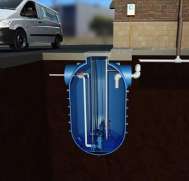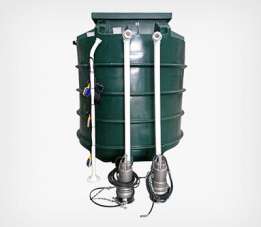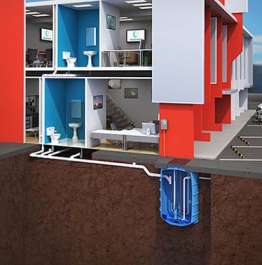The difference between concrete, polyethylene, and fibreglass pump stations
Every construction site, industrial facility, mine, caravan park, and residential home needs to process sewage, wastewater, and stormwater. Sometimes the slope of the land makes this easy, and it’s just a matter of piping the discharge into the nearest available sewer (assuming there is a trade waste agreement in place, of course).
But sometimes the layout of the site is more complicated, and water must be collected and pumped to the appropriate sewer. This is where pump stations come in.

What is a pump station?
A pump station consists of an underground tank, for collecting water, and pumps that discharge this water into the sewer. As you can imagine, there are vast differences between a system designed for a single residence compared to an industrial facility. Some pump stations are made from fibreglass, others from polyethylene or concrete.
How can you assess the best pump station solution for your needs? Let's take a look.
Summary of pump station differences
| Fibreglass | Polyethylene | Concrete | |
|---|---|---|---|
|
Size range |
100L to 10,000L |
100L to 10,000L |
> 10,000L |
|
Suitable for charged ground |
Up to a limit before tank buckles or floats |
Up to a limit before tank buckles or floats |
No problems with charged ground |
|
Ease of installation |
Very easy |
Very easy |
Complex (may require the use of a crane) |
|
Vulnerability to leaks |
Can be damaged by construction crews. Can develop pinhole leaks |
Can be damaged by construction crews. Can develop pinhole leaks |
Good sealing will prevent leaks |
|
Ease of pipe connections |
Easy to core through fibreglass and easy to seal |
Easy to core through fibreglass and easy to seal |
More difficult to seal pipework joins through sidewalls |
|
Fixing of pumps |
Can be challenging to fix pumps, clamps, and chains to sidewalls |
Can be challenging to fix pumps, clamps, and chains to sidewalls |
Easy attachment to sidewalls |
|
Cost |
Cheaper for small volumes up to 10,000L |
Cheaper for small volumes up to 10,000L |
Cheaper for larger volumes greater than 10,000L |
Fibreglass pump stations

Fibreglass is a very resilient material which is ideal for small to midsize pump stations. It resists chemical attack, making it suitable for industrial wastewater applications. An extra advantage of fibreglass systems is that they can be customised to site requirements.
This could be a significant benefit where unusual tank shapes are required or where the depth for lowering a pump station is limited. Using a concrete base or concrete encasement will help to resist the upward pressure of water in charged ground, however it is always advisable to seek expert advice to ensure the installation is safe and will not leak.
Polyethylene pump stations
Polyethylene is a durable material used in many residential and industrial applications. It is moulded into the tank shape and volume required; and it's strengthened by increasing wall thickness. Polyethylene is light and easy to handle, making installation of pump stations a simple construction exercise. A concrete base or encasement can be used in a similar way to fibreglass pump stations in charged ground.
Concrete pump stations
Concrete pump stations are primarily used for large-volume applications between 10,000 litres and 30,000 litres. Even larger pump station capacities are available on request. The weight of concrete construction completely eliminates the risks associated with charged ground. Once the concrete structure is set in place, it will not move regardless of ground water pressure.
Concrete also provides strong sidewalls for attaching pumps and chains. Removing and replacing pumps will not stress the structure above its design conditions. However, a disadvantage of concrete pump stations is the difficulty to make adjustments. Coring through sidewalls is a substantial operation and once pipework is in place, it is not advisable to move it to different locations in the tank.
Choosing your pump station
Choosing the right pump station solution for your needs may not be as simple as it first appears. It is advisable to get expert assistance to evaluate your site and help you choose the best option. The primary criteria for choosing a pump station material type are as follows:

- The volume of the pump station. Required volume is determined by the number of connections to the pumps station, flow rates, and invert levels.
- The civil conditions of the site. These include groundwater levels as well as hardness of the ground, in terms of being able to dig deep enough for the pump station installation.
- The project budget. Polyethylene and fibreglass pump stations are cheaper for small to midsize applications.
Polyethylene and fibreglass pump stations are cheaper and easier to install for smaller volumes. However, care should be taken in charged ground. For large volume applications, concrete pump stations are cheaper and more suitable.
Contact Cleanawater for pump station advice
Cleanawater is a one-stop water treatment provider for the Australian market. We supply off-the-shelf pump station solutions for most applications using fibreglass or polyethylene construction.
Our technical experts have experience in large and small projects with varying site conditions. Find out more at Cleanawater, or call our expert team on 1800 353 788 today to arrange a consultation for your pump station needs.
Must Read
What to Expect During a Modular Wash Bay Installation
CleanaWater, we make the process of installing a modular wash bay on your site as smooth and straightforward as possible. ...
Read moreThe CleanaWater Team Driving Water Treatment and Sustainability
CleanaWater is powered by a dedicated team of professionals who bring expertise and passion to every project. ...
Read more